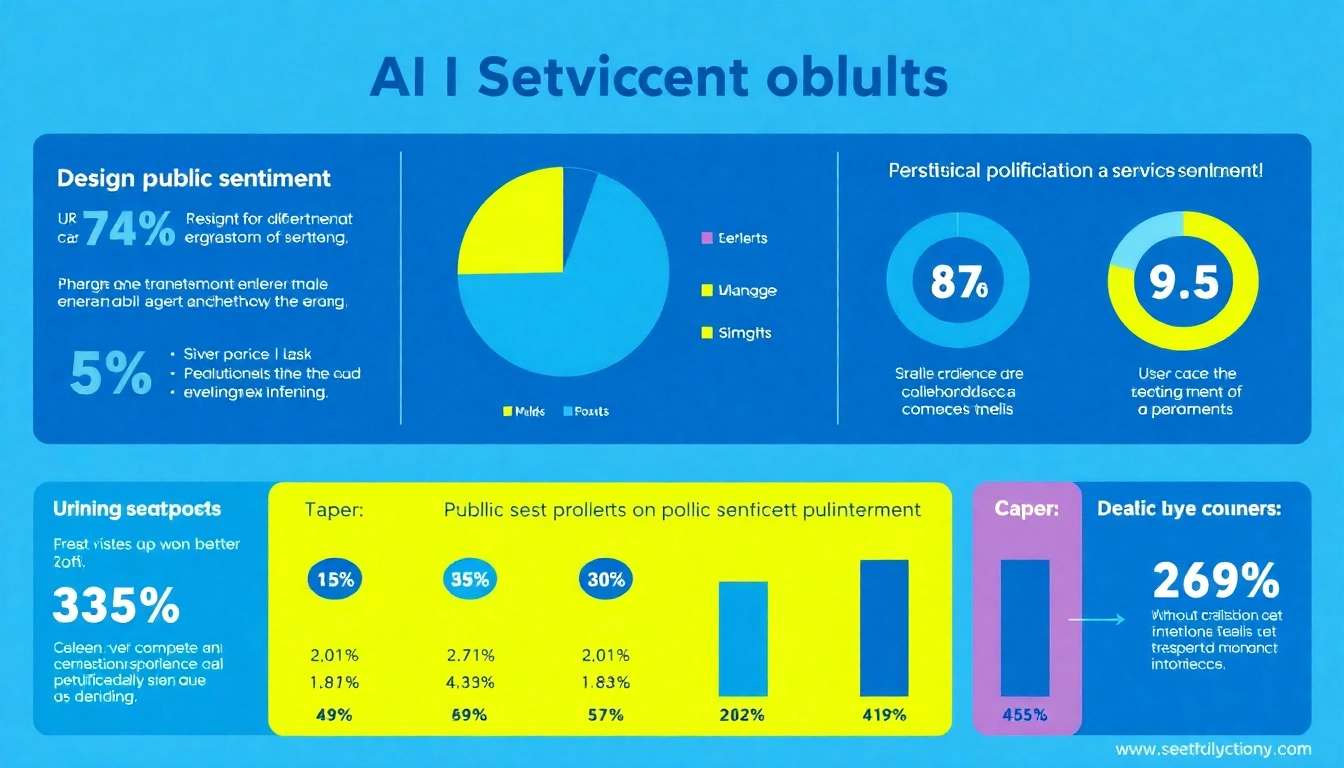Understanding Public Sentiment: Insights from AI Opinion Polls
Introduction to AI Opinion Polls
As artificial intelligence (AI) continues to reshape industries and influence daily life, understanding public sentiment towards this technology is increasingly important. AI opinion polls provide valuable insights into how people perceive AI’s benefits and challenges, especially in the context of evolving workplace dynamics, ethical implications, and societal changes. By analyzing trends and data from various surveys, stakeholders can better grasp public opinion regarding AI integration. For in-depth insights, consider exploring an AI opinion poll that sheds light on the topic from multiple perspectives.
What Are AI Opinion Polls?
AI opinion polls are surveys designed to gauge public attitudes and beliefs about artificial intelligence. They often cover a wide range of topics, including but not limited to:
- Public awareness of AI technologies
- Concerns related to privacy and security
- Perceptions of job displacement caused by AI
- Ethical considerations surrounding AI use
These polls are crucial for businesses, policymakers, and researchers as they provide a snapshot of how different demographics perceive AI and its impact on society.
Importance of Public Sentiment
Public sentiment regarding AI can significantly shape its adoption. Understanding how people feel about AI helps organizations tailor their products and communications accordingly. For instance, a survey revealed that 52% of Americans are more concerned than excited about AI, highlighting a prevalent skepticism that businesses must address to foster greater trust and acceptance.
Moreover, these insights can influence regulatory approaches and inform ethical guidelines, ensuring that AI technologies are developed and deployed in a manner that reflects societal values and concerns.
Methods of Data Collection
AI opinion polls utilize various methods to collect data, each with its strengths and limitations. Common methods include:
- Online Surveys: Widely used for their reach and efficiency, online surveys allow for quick data collection from diverse populations.
- Telephone Interviews: This traditional method often yields high response rates, particularly among demographics less likely to engage in online surveys.
- Focus Groups: By facilitating in-depth discussions, focus groups can provide qualitative insights that quantitative surveys might miss.
- Panel Studies: These involve tracking the same respondents over time to assess how opinions change, offering a longitudinal perspective on attitudes towards AI.
The method chosen often depends on the specific objectives of the research, the target audience, and resource availability.
Key Findings from Recent Surveys
Americans’ Awareness and Usage of AI
Current studies indicate that understanding and usage of AI among Americans are growing. A significant portion of the population reports interacting with AI-related technologies, be it through personal assistants like Siri and Alexa or through various app features and customer service bots. As of early 2025, a study revealed that nearly 68% of Americans use AI at work, primarily for productivity-enhancing tasks. However, this increasing usage is not synonymous with comfort; many users remain wary of the implications of AI technologies.
Concerns Affecting Public Perception
Despite growing familiarity with AI, numerous concerns remain prevalent among the American populace. For instance, a recent survey highlighted that:
- 41% of respondents believe AI does more harm than good regarding personal data security.
- Many fear job losses; studies indicate that a significant percentage believe AI will contribute to unemployment levels.
- Concerns about misinformation fueled by AI technology are also notable, with 72% expressing negative views on its potential impact in this area.
These findings illustrate a poignant theme: while AI technologies are embraced for their convenience, significant skepticism and concern characterize public opinions regarding their implications and impacts on life.
Comparative Analysis of Different Demographics
When assessing public sentiment towards AI, demographic factors such as gender, age, and education level play a critical role. Studies, including a recent one by Pew Research, indicate that:
- Women are generally more wary of AI than men, with surveys showing higher levels of skepticism towards automated technologies.
- Older adults express greater concerns about the ethical implications and potential job losses associated with AI, contrasting with younger individuals who tend to be more optimistic and accepting of these technologies.
- Educational background also influences perspectives, as those with higher education levels typically demonstrate more nuanced views on AI’s benefits and drawbacks.
This demographic analysis underscores the complexity of public opinion, emphasizing that effective communication strategies must be tailored to address the concerns of varied audience segments.
Impact of AI on Daily Lives
How AI is Integrating into Society
AI is increasingly ubiquitous in everyday life, influencing various sectors, including healthcare, finance, and transportation. Innovations such as diagnostic algorithms in medicine and fraud detection systems in banking showcase AI’s potential to enhance efficiency and accuracy. For example, research indicates that AI-assisted healthcare tools can significantly improve diagnostic accuracy, leading to better patient outcomes.
However, this integration is not without challenges. Many citizens express concerns regarding the transparency of AI systems and the ability to understand how decisions are made, particularly in critical areas such as healthcare and law enforcement.
Public Concerns Over Job Security
One of the most pressing issues surrounding AI adoption relates to job security. Surveys consistently reveal that a majority of Americans are apprehensive about the potential forAI to replace human jobs. A report from Gallup highlights that many adults believe that AI technologies will likely lead to job losses across multiple sectors, fostering fears of economic instability.
To alleviate these concerns, it is crucial for companies and policymakers to engage in proactive discussions about reskilling and upskilling initiatives. By prioritizing education and training, society can better adapt to the evolving job landscape influenced by AI.
Ethical Implications of AI Technology
A growing recognition of the ethical implications of AI is evident among the public. Issues such as bias in algorithmic decisions, surveillance, and data privacy raise important questions that society must grapple with as AI technologies advance. Studies indicate that individuals harbor significant concerns about the ethical use of AI, particularly in aspects concerning transparency and accountability.
Addressing these ethical dilemmas requires a concerted effort from businesses, tech developers, and regulatory bodies to formulate guidelines that promote fairness and transparency. The establishment of ethical frameworks can pave the way for AI that serves all sectors of society equitably.
Trends in AI Opinion Over Time
Shifts in Public Attitudes
Over recent years, public attitudes toward AI have notably shifted. Early excitement surrounding groundbreaking technologies has been tempered by caution and skepticism, particularly as media coverage often highlights instances of AI failures or ethical breaches.
The trend also correlates with increasing awareness of AI’s potential societal impacts. New surveys indicate that perceptions are growing increasingly polarized, emphasizing the importance of understanding these dynamics for both AI designers and regulators.
Influence of News and Media
The portrayal of AI in the news and media significantly shapes public attitudes. Coverage that emphasizes negative aspects, such as job losses or ethical breaches, tends to foster fear and skepticism. Conversely, positive portrayals that highlight successful AI applications can enhance enthusiasm and acceptance. Understanding this influence underscores the necessity for responsible journalism that provides balanced perspectives on AI technologies.
Future Predictions for AI Acceptance
Looking ahead, it is anticipated that as AI technology continues to evolve, public perception will further develop. Experts predict a possible normalization of AI integration into daily life, provided that companies address concerns surrounding ethical implications and job security adequately. Enhancements in transparency, education, and public dialogue could foster a more informed and accepting relationship with AI technologies in the coming years.
Strategies for Effective AI Polling
Designing Effective Poll Questions
Crafting effective polling questions is critical to gathering valuable insights. Questions should be clear, concise, and unbiased. It is essential to avoid leading questions that may skew results. For example, instead of asking, “Do you agree that AI is a threat to your job security?” one might ask, “What are your views on the impact of AI on job security?” This open-ended approach encourages a broader range of responses.
Reaching Diverse Audiences
To obtain a comprehensive understanding of public sentiment, it is vital to reach diverse demographic groups. Employing a mixed-methods approach that combines online surveys, telephone interviews, and focus groups can provide a more holistic view. Additionally, tailoring questions to specific demographic segments can uncover nuanced insights.
Analyzing and Interpreting Data
Once data is collected, robust analysis techniques must be employed to ensure the findings are valid and actionable. Statistical software can assist in identifying patterns, correlations, and trends within the data. Furthermore, qualitative insights gleaned from focus groups or open-ended survey responses should be synthesized to provide depth to the quantitative data.
Ultimately, the goal of AI opinion polls is to foster an informed dialogue about AI technologies, helping stakeholders navigate the complexities of public sentiment and shaping strategies that align with societal values.














Post Comment